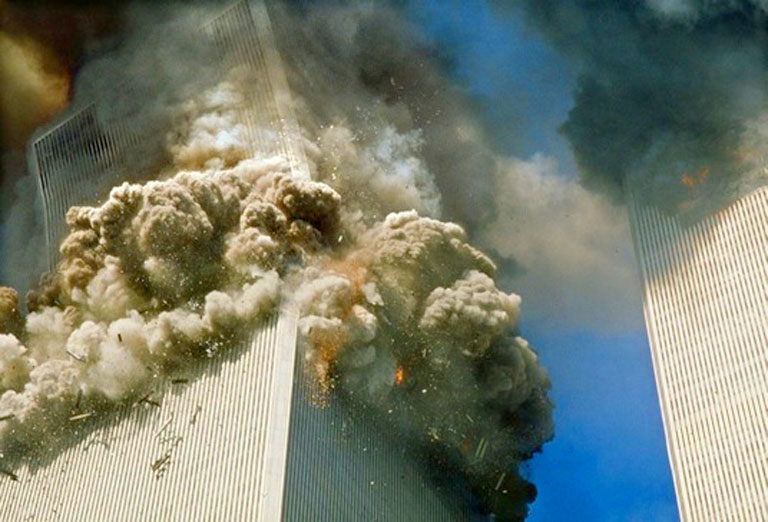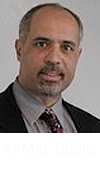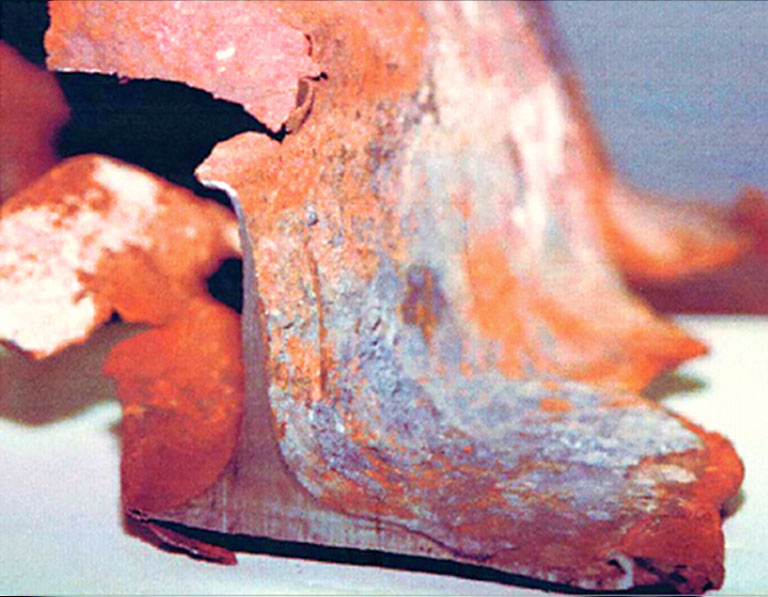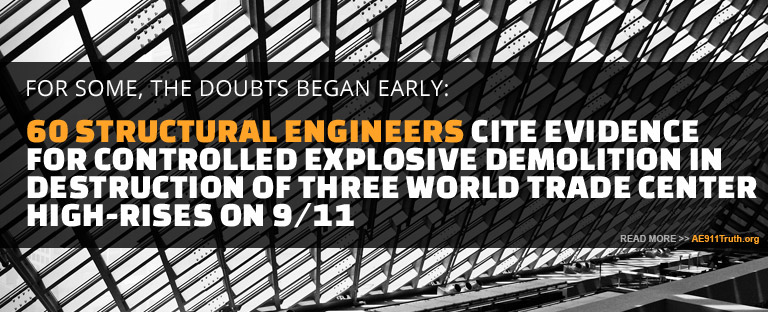How could all 47 core columns fail at the same instant? Fires could not do that.
Official Collapse Theory Defies All Laws of Physics
By James McDowell and AE911Truth Staff
Since its inception in 2006, Architects & Engineers for 9/11 Truth has remained steadfast in its mission of exposing the flaws in the claims made by the National Institute of Safety and Technology (NIST) — namely, that the impact of two planes and the resulting fires brought down three steel-framed skyscrapers on September 11, 2001. We do scientific, cogent, and comprehensive analyses, backed by forensically-tested, unassailable facts.
One outcome of our insistence on remaining true to our mission is that our ranks of signatories has swelled from less than a dozen to more than 2,300 building and technical professionals who are petitioning the government for a new, independent investigation of the catastrophic destruction at the World Trade Center on 9/11.
Additionally, over 20,000 citizens have signed the AE911Truth petition, and more than 250,000 supporters have "liked" our Facebook page. Last August we introduced this once-taboo topic with a 45-minute interview on C-SPAN, foiling a mainstream media blackout and allowing a national audience of millions to finally hear the most poignant — and suppressed — facts about that fatal day.
While much of AE911Truth's success can be ascribed to the perseverance of its founder and the other members of its board of directors, who have remained focused on the science, none of its achievements would have been possible without the professional credibility lent by an ever-growing contingent of professional signatories: structural engineers. The members of this distinguished group, numbering 60 to date, are experts in the capability of steel-frame structures to resist all kinds of forces. Their courage in stepping up to speak the “inconvenient truth” secures for them a venerable place as “the scientific backbone” of AE911Truth.
 Five years after 9/11, San Francisco Bay Area architect Richard Gage, AIA, began raising technical questions among his professional colleagues about the destruction of the Twin Towers and 47-story WTC Building 7. He realized that an organized effort by building professionals and scientists was needed to shine light on the government's false version of 9/11. In the years since founding AE911Truth, Gage has discovered that those who take time to look at the facts overwhelmingly agree that vital questions about the forensic evidence and video testimony remain unanswered by government officials.
Five years after 9/11, San Francisco Bay Area architect Richard Gage, AIA, began raising technical questions among his professional colleagues about the destruction of the Twin Towers and 47-story WTC Building 7. He realized that an organized effort by building professionals and scientists was needed to shine light on the government's false version of 9/11. In the years since founding AE911Truth, Gage has discovered that those who take time to look at the facts overwhelmingly agree that vital questions about the forensic evidence and video testimony remain unanswered by government officials.
That's why he and more than 2,300 other degreed and/or licensed architects and engineers — including 60 structural engineers who hail from the US, Canada, Australia, the UK, and Europe — have signed the petition that demands an unbiased, unimpeachable investigation of the World Trade Center's destruction. Every day, more professionals — all of them carefully vetted by AE's verification team — join the existing signatories.
For Some, the Doubts Began Early
“Something is wrong with this picture,” thought Nathan Lomba, S.E., P.E., of Eureka, California, as he watched televised replays of the Twin Tower collapses on September 11, 2001. As a licensed structural engineer trained in buildings’ responses to stress, Lomba saw more on the screen than did the average viewer. He tried to answer this perplexing question, “How did the structures collapse in near-symmetrical fashion when the damage was clearly not symmetrical?”
Lomba was hardly alone in his doubts and discomfort that day. Whether they publicly admit it or not, and whether they saw the events unfold "live" or watched endless television and internet reruns later, most building professionals — or individuals with any knowledge of building collapses — were surprised when the towers fell. Demolitions expert Van Romero voiced his thoughts the day the planes struck, though he unaccountably reversed his position ten days later. Also early on, MIT engineer and research scientist Jeff King made his first impressions of 9/11 known in this speech. Even TV anchors (see here and here, for example) expressed their unfiltered opinions on the air that fateful day.
How did the structures collapse in near-symmetrical fashion when the damage was clearly not symmetrical?
By and large, though, building professionals kept their misgivings to themselves. In the ensuing days, weeks, and months, they watched in bewilderment as reputable magazines like Scientific American and the Journal of Engineering Mechanics, well-regarded television stations like the BBC and The History Channel, and government agencies including NIST and the Federal Emergency Management Agency (FEMA) trotted out varying and imaginative hypotheses as to how fires could have leveled all three high-rise structures.
Many structural engineers, like Lomba, find the unnatural symmetry of the fall of all three skyscrapers highly suspicious. The rapidity of collapse — eventually acknowledged by NIST as free-fall acceleration — also troubles them. Some note that the fires were weak, low-temperature, and short-lived. Others ask how the tilting upper section of the South Tower, WTC 2, “straightened” itself. Everywhere they look, pieces of the puzzle “don’t fit with what we’ve been told,” these engineers insist.
 New evidence that has come to light over the years but was omitted from government reports — dozens of eyewitness testimonies of explosions, unexplained molten iron in the debris pile, and chemical evidence of steel-cutting incendiaries — has only validated these engineers' initial suspicions.
New evidence that has come to light over the years but was omitted from government reports — dozens of eyewitness testimonies of explosions, unexplained molten iron in the debris pile, and chemical evidence of steel-cutting incendiaries — has only validated these engineers' initial suspicions.
More than a few of them also point to the implausible aspects of civil engineering professor Zdenĕk Bažant's pile driver model, first published a mere two days after 9/11, which these engineers view as a rush to judgment based on extremely limited data, and later codified in his 2008 analysis.
They also cite the impossibilities — as well as slipshod and dishonest methodology — of both the 2002 FEMA report and the NIST final reports on the Twin Towers (2005) and Building 7 (2008).
Mystifying many of these professionals is the abrupt fall, in the late afternoon of 9/11, of WTC 7, which was not hit by an airplane but only by debris ejected from the North Tower when it came down. The repeated postponement of the government’s reports only added figurative fuel to the fire, in the minds of many a skeptical engineer.
Artificial Symmetry
 The symmetry of collapse struck both Paul Mason, a structural engineer in Melbourne, Australia, and Dennis Kollar, P.E., a structural engineer in Wisconsin, as disconcerting. Kollar remains troubled by the “totality and uniformity of the destruction” and by the fact that “the mass of debris remained centered on the building core all the way down.”
The symmetry of collapse struck both Paul Mason, a structural engineer in Melbourne, Australia, and Dennis Kollar, P.E., a structural engineer in Wisconsin, as disconcerting. Kollar remains troubled by the “totality and uniformity of the destruction” and by the fact that “the mass of debris remained centered on the building core all the way down.”
John Watt, a chartered structural engineer in Edinburgh, UK, voices similar concerns. “With respect to the Twin Towers," he says, “the main puzzle was how two buildings with highly asymmetric damage could fail vertically downwards into the strongest part of the buildings — their steel-columned cores. And not only fail vertically, but at a speed that indicated structural resistance being removed sequentially from under the collapse wave. Few engineers would imagine buildings a quarter-of-a-mile high failing vertically, into their main structures, rather than failing laterally — given the eccentric damage.”
The towers should have fallen “with increasing eccentricity as the collapse progressed,” observes Howard Pasternack, P.Eng., of Toronto, Canada. Moreover, these systematic collapses required that many structural connections not only fail “nearly simultaneously, but also in sequential order,” according to Frank Cullinan, P.E., who designs bridges in Northern California. That’s “impossible from asymmetrical impact loading and . . . small, short-duration fires.”
 The engineers find it difficult to believe the government’s claim that scattered fires brought about such an orderly collapse. Failure of heat-weakened steel would show “large deflection, asymmetric local failure, and slow progress,” David Scott, C.Eng., a chartered consulting structural engineer in the UK, told colleagues at the Institution of Structural Engineers in the UK. It’s “a gradual process,” agrees Anders Björkman, and “cannot be simultaneous everywhere.” A Swedish naval architect and marine engineer working in France, Björkman maintains that failures “will always be local and topple the mass above in the direction of the local collapse.”
The engineers find it difficult to believe the government’s claim that scattered fires brought about such an orderly collapse. Failure of heat-weakened steel would show “large deflection, asymmetric local failure, and slow progress,” David Scott, C.Eng., a chartered consulting structural engineer in the UK, told colleagues at the Institution of Structural Engineers in the UK. It’s “a gradual process,” agrees Anders Björkman, and “cannot be simultaneous everywhere.” A Swedish naval architect and marine engineer working in France, Björkman maintains that failures “will always be local and topple the mass above in the direction of the local collapse.”
 William Rice, P.E., a Vermont licensed structural engineer, expects fire-induced failures to be “tilting, erratic and twisting,” while Ronald Brookman, S.E., a licensed structural engineer in Novato, California, figures on “a partial collapse to the side.”
William Rice, P.E., a Vermont licensed structural engineer, expects fire-induced failures to be “tilting, erratic and twisting,” while Ronald Brookman, S.E., a licensed structural engineer in Novato, California, figures on “a partial collapse to the side.”
“Symmetrical collapse requires simultaneous failure of all supporting columns,” notes Charles Pegelow, P.E., a Houston, Texas, licensed civil engineer who has performed design work on numerous tall buildings as well as oil rigs. “How could all 47 core columns fail at the same instant?” Pegelow wondered briefly, then concluded definitively, “Fires could not do that.”
Impossible Collapse Acceleration
After NIST characterized the Twin Towers’ collapse as “essentially in free fall” (See Section 6.14.4 of NIST NCSTAR 1, page 146 [PDF page 196]), Brookman wrote to NIST investigators, asking why debris fell “with little or no resistance from the intact structure below.”
And, though Rice didn’t address NIST directly, he, too, questioned — and continues to question — how each tower “inexplicably collapsed upon itself, crushing all 287 columns on each floor, while maintaining near-free-fall acceleration, as if the 80,000 tons of supporting structural steel framework underneath didn’t exist.”
Falling objects, notes Pasternack, should take “the path of least resistance,” yet official explanations claim that tower debris took the path of greatest resistance, through the strong core structure all the way to the ground.
 The Twin Towers were overbuilt to prevent office workers from getting seasick on windy days, says Kollar. “There’s so much redundancy. . . . The building has to be stiff enough so it doesn’t sway [excessively].” Perimeter columns designed to endure hurricanes, Scott says, were loaded only to “about 10% of their ultimate capacity” in the gentle breeze on 9/11. (See “How Columns Will Be Designed for 110-Story Buildings,” Engineering News-Record, April 2, 1964.)
The Twin Towers were overbuilt to prevent office workers from getting seasick on windy days, says Kollar. “There’s so much redundancy. . . . The building has to be stiff enough so it doesn’t sway [excessively].” Perimeter columns designed to endure hurricanes, Scott says, were loaded only to “about 10% of their ultimate capacity” in the gentle breeze on 9/11. (See “How Columns Will Be Designed for 110-Story Buildings,” Engineering News-Record, April 2, 1964.)
Gravity was “a negligible part of the loading,” says Kollar, citing a claim by the Twin Towers’ engineers Worthington, Skilling, Helle & Jackson that even with all the columns on one side — and several around the two corners — cut, each tower would still withstand 100 mile-per-hour winds. (See James Glanz and Eric Lipton, City in the Sky: The Rise and Fall of the World Trade Center, New York: Times Books, 2003.)
The rapid breakup of these robust structures appears to defy the laws of physics, AE911Truth engineers say. Fifty years of structural design experience inform the view of Santa Rosa, California, licensed structural engineer Bob Briscoe, P.E., who maintains that the government’s collapse theories “defy the laws of mechanics, conservation of energy, and known structural failure behavior.”
In the official collapse story, the kinetic energy (of motion) of the falling debris would have been largely absorbed by the existing structure, bending and twisting steel components, and breaking up 220 acres of concrete floors. To accomplish all this while achieving a nearly free-fall collapse is “simply not physically possible,” says Mason. “There is not sufficient energy available . . . . For this massively strong structure to just crumble away at near-free-fall acceleration would have required immense amounts of explosive energy.”
Weak Fires vs. Explosive Events
Though four official accounts blame fire for the destruction of all three World Trade Center towers, the fires do not appear to have been particularly severe, the engineers contend. In fact, even NIST states that the jet fuel burned off in just minutes. (See NIST NCSTAR 1, page 183 [PDF page 233].)
The government agency even “acknowledged that office furniture burns up in only about 20 minutes in any one area” before it’s consumed, Scott points out. “There’s ample evidence that the steel temperatures got nowhere close to the “600+ degrees Centigrade [1,200 degrees Fahrenheit] required to initiate failure.” (See NIST NCSTAR 1, page 129 [PDF page 179] and page 183 [PDF page 233].)
That does not look anything like a heat-induced, gravitational collapse mechanism
We saw no “raging infernos” on TV, notes David Huebner, P.E., a licensed structural engineer in Michigan. On the contrary, sooty smoke and dull red flames indicate “cool fires . . . fuel-starved fires,” says Scott. He adds that firefighters working at the 78th-floor impact zone reported “only two small fires, not the 1,000-degree-Centigrade inferno” that government officials claim.
New York Fire Department (FDNY) personnel, trained to assess fires’ structural hazards, had no reason to expect total collapse, Brookman maintains. In fact, Scott notes, several steel-framed towers have burned longer, hotter, and much more intensely without collapse. “As engineers, we know what fire can do to steel and what it can’t.”
“Over 100 recorded witnesses reported hearing and seeing multiple explosions,” Rice recalls.
Brookman, too, cites “numerous eyewitness accounts, including the FDNY oral histories, of secondary explosions . . . well below the impact floors.” His letter to congressional representatives describes “explosive clouds of dust and debris moving horizontally and vertically.” “That does not look anything like a heat-induced, gravitational collapse mechanism,” Brookman writes. Rice, noting that “perimeter columns weighing several tons each were ejected laterally up to [600] feet,” contends that this phenomenon is “not possible without explosives.”
Angular Momentum Arrested
As the South Tower began to fail, the top 29 stories tipped as a unit, photos show. “The tilting block doesn’t look right,” Brookman asserts. It should “continue to rotate and fall to the ground.” Phoenix, Arizona, licensed structural engineer Edward Knesl, S.E., and Lomba echo Brookman. The failure mode of such tall structures should have been “a fall over to the side” (Knesl) and “a toppling of the upper floors to one side, . . . not a concentric, vertical collapse” (Lomba). “It looked like an explosive event,” adds Brookman. “[The upper section] began tilting toward the damage zone, and then suddenly dropped straight down and disintegrated in the process.”

Figure 1. The South Tower's top tilted 22 degrees to the left, then disintegrated straight down into the rubble cloud.
Building 7’s Mystifying Implosion
Baffling as the towers’ “collapses” were, even more perplexing to the 60 structural engineers was the destruction of World Trade Center Building 7. “Unprecedented,” says Rice. “Unexplainable,” vouches Huebner. After all, as all the engineers know, and as London chartered structural engineer Graham Inman declares bluntly on their behalf, “No plane hit this building.”

Figure 2. WTC 7 came down in full free-fall for at least the first third of its fall. Its structure completely shattered in under seven seconds.
 Few Americans have given any thought to the third World Trade Center high-rise destroyed on September 11th, since it, unlike the Twin Towers' destruction, was not repeatedly televised. Fremont, California-based Kamal Obeid, S.E., a consulting licensed structural engineer, ponders the fall of the third high-rise structure. “A localized failure in a steel-framed building like WTC 7 cannot cause a catastrophic collapse like a house of cards without a simultaneous and patterned loss of several of its columns at key locations within the building,” he contends.
Few Americans have given any thought to the third World Trade Center high-rise destroyed on September 11th, since it, unlike the Twin Towers' destruction, was not repeatedly televised. Fremont, California-based Kamal Obeid, S.E., a consulting licensed structural engineer, ponders the fall of the third high-rise structure. “A localized failure in a steel-framed building like WTC 7 cannot cause a catastrophic collapse like a house of cards without a simultaneous and patterned loss of several of its columns at key locations within the building,” he contends.
Videos of Building 7 show “simultaneous failure of all columns,” says Inman, “rather than [the expected] phased approach,” in which undamaged columns would show resistance sequentially.
Though the 47-story building housed “offices of the CIA, the Secret Service, and the Department of Defense, among others,” Rice notes that the 9/11 Commission left WTC 7’s collapse out of its report. FEMA’s 2002 inquiry blamed WTC 7’s collapse on fires, though it admitted that its “best hypothesis [fire] has only a low probability of occurrence.” The mainstream media, says Rice, have “basically kept the collapse of WTC Building #7 hidden from public view.”
The Phantom Pile Driver
A mere two days after 9/11, Dr. Zdeněk Bažant, a civil engineering professor at Northwestern University, offered a highly stretched rationale for the most catastrophic structural failure in history. Thirteen years later, his thesis (see Bažant’s 2008 final analysis) remains the key support for the government's claim that the collapses were “inevitable.” (NIST used the word "inevitable" in its NCSTAR 1 report on WTC 7 twice — once on page xxxvii [PDF page 39], footnote 2, and again on page 82 [PDF page 132], footnote 13.)
Bažant’s mathematical model of the upper floors’ transformation into a “pile driver block” free-falling one story to hammer the entire tower down to the ground involves “very misty allegations — actually inventions,” says Björkman. His opinion derives from 40 years in ship surveying and construction, design of tankers and seagoing ferries, and practical observations of steel vessels after collisions. Never before, Björkman notes, has “a smaller object (the light-weight, upper, actually non-rigid, flexible steel structure consisting of many smaller parts) destroyed the bigger and stronger other object (the complex steel structure below) only with the assistance of gravity.”
Björkman scoffs at Bažant’s mythical free-falling top block bringing 287 columns hammering down in perfect array on the 287 columns below. Steel bends and mashes in Björkman’s salty world, and “it is not certain that the hammer even hits the nail.” Real-life columns miss, lodge in horizontal structures, and punch holes in floors, creating energy-absorbing frictions, deformed steel, local failures, and “a soft collision (not impact!)” that tangles damaged floors in a shuffled array — and stops well short of total collapse.
The marine engineer maintains that videos show Bažant’s alleged pile driver disintegrating “within 3.5 seconds after the roof starts to fall, . . . before global collapse starts!” Björkman challenges Dr. Bažant and his followers to produce a “timetable, analysis, and explanation” consistent with the video evidence. “And tell us . . . what happened to the upper block?!”
Molten Iron “Flowing Like Lava”
As far as Watt is concerned, the most compelling evidence for controlled demolition is the numerous reports of molten steel. “These came from firemen and rescue personnel involved in the initial rescues immediately after the collapses then many weeks after the collapses, where red-hot molten steel was noted. From extensive research into office building fires, we know that while steel can deform under office fire temperatures, it comes nowhere close to melting. If steel had melted due to fires at the high levels, we would again expect a tilting failure, not vertical collapse.”
Steel starts melting at 2,700° F, almost 1,000° hotter than burning jet fuel or office fires, notes Pegelow. “Why did the NIST investigation not consider reports of molten steel in the wreckage?” he asks. FDNY Captain Philip Ruvolo reported seeing “molten steel . . . like you were in a foundry, like lava.”
Even Leslie Robertson, one of the design engineers of the World Trade Center and a supporter of the official collapse story, acknowledged, “So when we were down at the B1 level [basement level 1], one of the firefighters said, 'I think you will be interested in this . . . .’ And they pulled out the big block of concrete, and there was like a little river of steel . . . flowing.”
According to Richard Garlock, a structural engineer in Robertson’s firm, “Going below . . . the debris past the columns was red-hot, molten, running.”
Dr. Abolhassan Astaneh-Asl, another supporter of the official story and the first structural engineer given access to the WTC steel, told PBS, “I saw melting of girders in [the] World Trade Center.”
Jet fuel cannot melt steel, but, asserts Rice, “thermite incendiaries can . . . create temperatures in excess of 4,000 degrees Fahrenheit, “instantly melting/severing short segments of steel columns and beams.” Chemical evidence of thermite found in the powdered debris by physicist Dr. Steven Jones is cited by Rice, by Obeid, and by Clark Townsend.

Figure 3. This sample of WTC steel that was partially melted is from the FEMA 403 report, Appendix C.
Brookman challenges NIST to explain tiny “iron-rich spheres found in the WTC dust,” which appear to be solidified droplets of once-molten iron.
Crucial Evidence Survives Discredited 2002 FEMA Report
The FEMA 403 report was “incomplete at best and a cover-up at worst,” says an anonymous East Coast AE911Truth petition signer and structural engineer whose name is being withheld by request. He notes that the report's Appendix C.2, found “evidence of a severe high temperature corrosion attack on the steel . . . with subsequent intergranular melting” forming a “sulfur-rich liquid” that “severely weaken[ed]” the structural steel.
Later in the same report (Appendix C.6), FEMA scientists added that “no clear explanation for the source of the sulfur has been identified.” The East Coast engineer finds FEMA's dodge unacceptable: “The report has uncovered an unexplainable phenomenon [within the context of the official story] that may have led to the collapse of the three WTC buildings. FEMA has stated that further study is needed, yet none has been commenced.”
Several of the structural engineers are outraged that evidence has not just been ignored; it was destroyed by officials. Destroyed evidence caused firefighters to riot at Ground Zero in protest of how the dead were being desecrated by the hasty “scoop and dump” clean-up of the structural steel debris.
“The destruction of the crime scene evidence is inexcusable,” Huebner holds. Scott laments the “mass of vital forensic evidence” lost. Even editor-in-chief Bill Manning of Fire Engineering magazine called FEMA’s investigation “a half-baked farce.”
Steel components were stamped with identification numbers that would have aided their reassembly for study, but that reassembly never took place. Brookman asks, “Why was the steel . . . not thoroughly examined by fire-safety and structural experts before being shipped to Asia for recycling?” Pegelow charges that “FEMA hampered and distorted the investigation,” citing Dr. Abolhassan Astaneh-Asl’s complaints in 2002 to the House Committee on Science that FEMA held back essential engineering drawings and videotapes and photographs.
Such flawed methodology was accompanied by inadequate theories that “cannot explain the loss of the cores,” Scott points out. He says FEMA’s notion that floor connections all failed simultaneously at the outer wall and at the core is “not plausible.” Bill Genitsaris, a structural engineer based in Melbourne, Australia, believes that a pancake-style collapse “should have left the supporting columns standing.” Such a collapse would have left 110 shattered floors in the building footprint below. Yet only very small floor sections were found, and not many of them.
 “Where are the columns?” asks licensed structural engineer Lynn Affleck, P.E., of Las Vegas, Nevada. “As the tallest buildings in the world at the time, they would have to have had huge steel columns to carry all the loads, wind, and earthquake forces. In the design of such premier buildings, they would have used the latest technology codes. It would be my assessment that the flanges on the columns would have to be two inches thick or some equivalent. Perhaps it might be possible that the building floors would pancake down, but the huge steel columns would be left protruding out the top as the floors went down. In such an event, [one would] be able to see columns located somewhere in the floor plan, which were continuous all the way down to the ground.”
“Where are the columns?” asks licensed structural engineer Lynn Affleck, P.E., of Las Vegas, Nevada. “As the tallest buildings in the world at the time, they would have to have had huge steel columns to carry all the loads, wind, and earthquake forces. In the design of such premier buildings, they would have used the latest technology codes. It would be my assessment that the flanges on the columns would have to be two inches thick or some equivalent. Perhaps it might be possible that the building floors would pancake down, but the huge steel columns would be left protruding out the top as the floors went down. In such an event, [one would] be able to see columns located somewhere in the floor plan, which were continuous all the way down to the ground.”
Deceptive presentation has further damaged FEMA’s credibility in the eyes of these engineers. Thomas Lackey, P.E., of Stowe, Vermont, a licensed structural engineer who designs bridges for the Vermont Agency of Transportation, cites the Minneapolis River Bridge collapse study as the “kind of analysis and straightforward explanation” the WTC investigation needed.
FEMA’s reports are so poorly done that some of its graphics “omit the cores altogether,” says Scott. Other graphics depict columns half as wide and twice as far apart as they actually were. Scott decries such “attempts to distort important technical information.” The Australian engineers use more colorful terminology: We have been “taken for suckers” (Mason) and “stooged” (Genitsaris).
Truncated and Fudged Computer Model Undermines 2005 NIST Report
By those who haven’t read its 10,000 pages, NIST’s $20 million report is generally believed to explain how fires and plane impacts destroyed the WTC. Then there are those, such as the AE911Truth structural engineers, who have read the entire report and who know that, as Brookman points out, it “not only fails to explain why and how the towers completely collapsed, but it states that the collapse became inevitable, without any further explanation.” He asks why NIST considered conservation of energy and momentum principles “only up to the moment prior to collapse.”
Scott makes the same complaint: NIST “stopped its computerized models before the onset of collapse. No work was done to calculate what happened during the actual failure. Why are we content with this?”
Sums up Brookman: “The complete collapse mechanism . . . cannot be ‘omitted for brevity’ in any comprehensive analysis.”
NIST’s Report on WTC 1 and WTC 2
NIST’s claim that a kinetic gravitational “attack” exceeded the WTC buildings’ reserve strength is not supported by any calculations or “by any evidence whatsoever or any serious structural analysis,” declares Björkman.
Equally troubling, while NIST fails to show essential work on central issues, its numerous volumes are packed with distracting trivia. Huebner, whose thirty years of structural engineering experience includes forensic investigation of structural collapses, compares NIST’s effort to a “college paper where you just keep adding [stuffing] to make the paper longer. Lots of pages of nothing! Definitely trying to cover up something.”
They’d simply adjust the input until the desired outcome is achieved
When Brookman asked NIST investigators to explain the “complete pulverization of building materials and contents” and “visibly explosive clouds of dust, ash, and debris,” he received no reply. “I believe in the laws of physics,” reasons Brookman, “and rely on them every day.” NIST's reports, however, chimes in fellow engineer Pasternak, “seem to require multiple leaps of faith in highly improbable events.”
“Computer models using NIST’s best estimates of temperature and damage could not even generate a collapse,” Scott points out. They’d “simply adjust the input until the desired outcome is achieved.” He believes NIST probably overestimated core column damage, almost certainly overestimated steel temperatures, and definitely overestimated damage to fire protection. Such an important inquiry should, Scott suggests, “rely on logical deduction, reason and first-principle analysis, not circular reasoning and adjusting models to get agreement with a preconceived explanation.”
47-Story Building 7’s Freefall Defies 2008 NIST Report
“We’ve had trouble getting a handle on building No. 7,” acknowledged NIST's 9/11 lead investigator Dr. Shyam Sunder to New York Magazine in 2006. That “trouble” is clearly reflected in NIST’s 2008 final report on WTC 7, which blames one buckling column, number 79, for the building’s global and near-symmetrical collapse, yet characterizes its fires as “normal office fires,” which typically burn only 20 minutes or so in any given location before moving on.
 David Topete, S.E., a San Francisco licensed structural engineer, asks why no other nearby buildings collapsed, when some of them were much more severely damaged by fire and Twin Tower debris than was Building 7.
David Topete, S.E., a San Francisco licensed structural engineer, asks why no other nearby buildings collapsed, when some of them were much more severely damaged by fire and Twin Tower debris than was Building 7.
Obeid rejects the official hypothesis that one failing column could cause adjacent columns to come down in such robustly designed buildings. “It is not possible for a local failure within the lower structure to spread horizontally,” he objects. “Such a failure would cause a break-away . . . instead of pulling the structure with it.” Even if NIST’s horizontal progression were somehow triggered, Obeid says, “the building would not have collapsed so neatly and symmetrically. All core columns have to be severed at the same time to make such a collapse.”
Disturbing Questions that Must Be Answered
“To preserve America’s unprecedented freedoms, we must pursue the truth,” reasons Santa Rosa, California, licensed structural designer Clayton Simmons, P.E. He admits to being troubled by “my profession’s involvement [i.e. the ASCE endorsement of the official story] in this apparent cover-up and the media’s refusal to address these critical questions.”
“Some years ago,” adds Affleck, “the media seemed to serve the purpose of keeping the government honest. Things would get reported and the government would have to scramble to explain. But [these days] the big media seems now to be the mouthpiece for the government.”
Watt agrees. “The evidence for molten steel has been officially denied so far. The evidence of many, many witnesses to explosions has been ignored. The evidence for explosive residues in 9/11 dust has never, to my knowledge, been officially investigated. And no coherent collapse mechanisms have been officially proposed. The silence on these matters is deafening.”
Scott, too, expresses consternation that structural engineers’ response “has been amazingly muted,” even “uninterested.”
Structural engineer Charles Walker sums up the common stance held by his colleagues: “They understand the truth yet have been unwilling to speak out against NIST's fraudulent claims, adopting instead passive postures such as 'Don’t rock the boat. Ignorance is bliss.’”
Rice observes that citizens aren’t the only ones who lack interest in ferreting out the facts of 9/11: He has also found politicians remarkably blasé.
Many people “remain willfully ignorant,” posits Genitsaris. “They believe that 9/11 does not affect their lives . . . regardless of the fact that our freedoms are being taken from us.” Perhaps so few are questioning, Brookman says, because it’s “painful to look directly at the events and consider the implications.” Affleck asserts, “Engineers and architects are being discounted as though they are ignorant. The official report and the way the media handled the 9/11 incident is basically an insult to the engineering profession.”
Toronto-based structural consultant William Acri, P.Eng., believes that the engineer’s oath “to hold public safety above all else” demands that the members of his profession speak up.
Indeed, if three modern steel high-rises really underwent total progressive collapse in less than two hours of relatively small fires and some damage to the fireproofing, seconds Scott, “we need to understand WHY!”
And, adds Inman, if WTC 7 failed from, substantially, a localized fire event, why didn’t the owners and insurers sue the designers? “Either the building design was criminally faulty or other causes not related to the structural design or fire” brought down WTC 7, he concludes.
Watt points out that the question of how three steel-framed multi-story buildings collapsed “is still, officially, an open question.” He goes on to say, “In a world of ever-increasing safety rhetoric and legislation, it is astonishing to professional engineers that there has not been a forensic investigation into the mechanisms of these collapses. Any aircraft suffering a catastrophic structural failure is subject to scrupulous investigation to help prevent recurring accidents and yet, in spite of these building structures being replicated all over the world, we have seen no significant structural changes in steel-framed buildings. The implications of this are deeply concerning to professional engineers interested in the safety of their designs.”
Why Should Science-Based Forensic Evidence Be Taboo?
The structural engineers we spoke to are calling for a new investigation into the catastrophic destruction of the three World Trade Center high-rises on September 11. “The implications of the controlled demolition evidence as outlined on our website are staggering,” says Gage, speaking on behalf of the group’s architects and engineers. “We therefore invite all Americans to examine the science-based forensic evidence very carefully and come to their own conclusions.”
Lomba’s conclusion, drawn from his initial perceptions and validated by subsequent developments, is clear: “Even if, for the sake of discussion, we accept the hypothesis that the fire protection was damaged and the fires somehow weakened the steel frames, that still does not explain the relatively concentric nature of the failures.”
Scott challenges his fellow structural engineers: “The building performance on 9/11 matched controlled demolition. It does not match fire-induced collapse. We have the expertise to discern this. Do we have the courage to broadcast it?”
END







